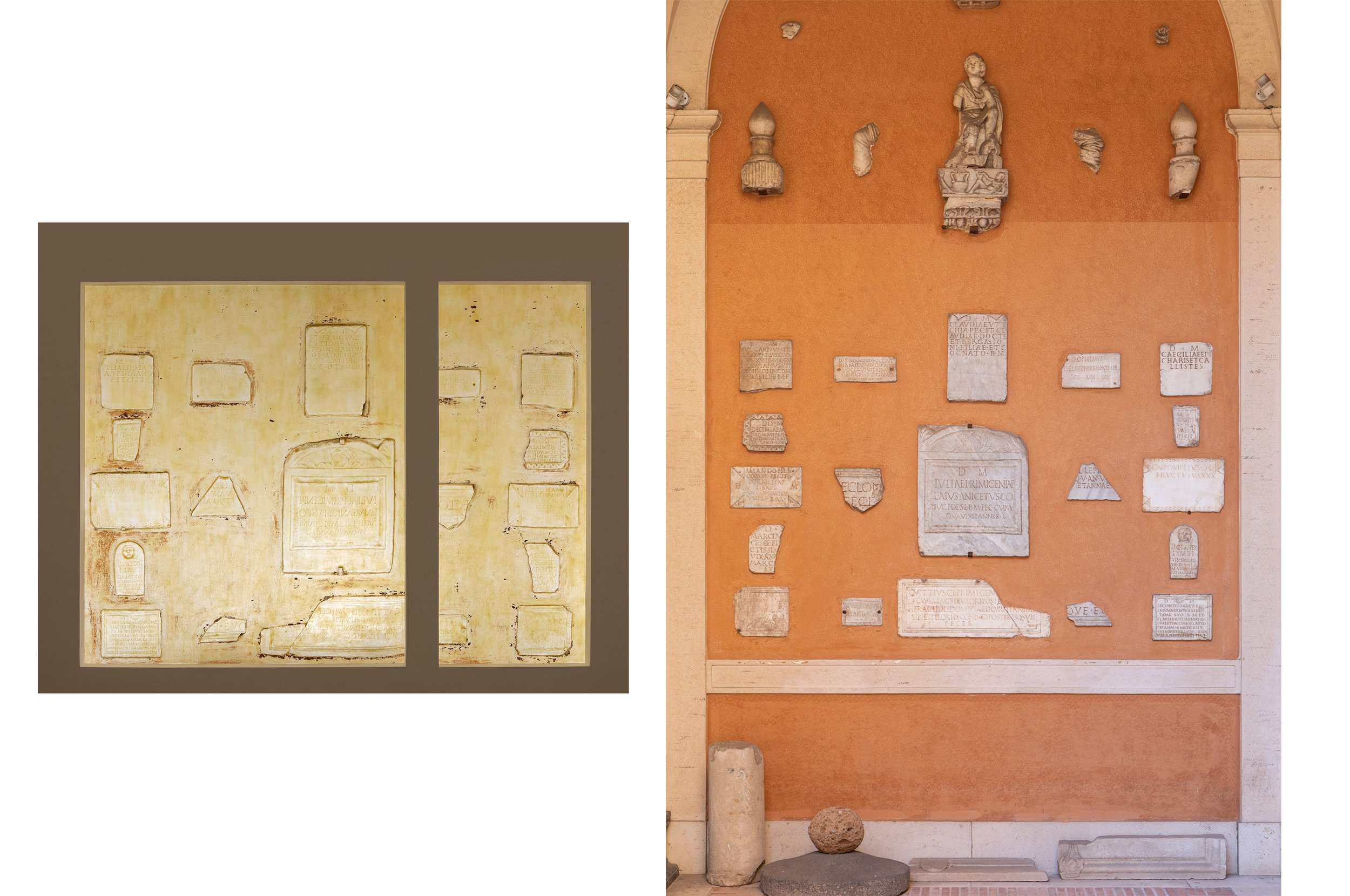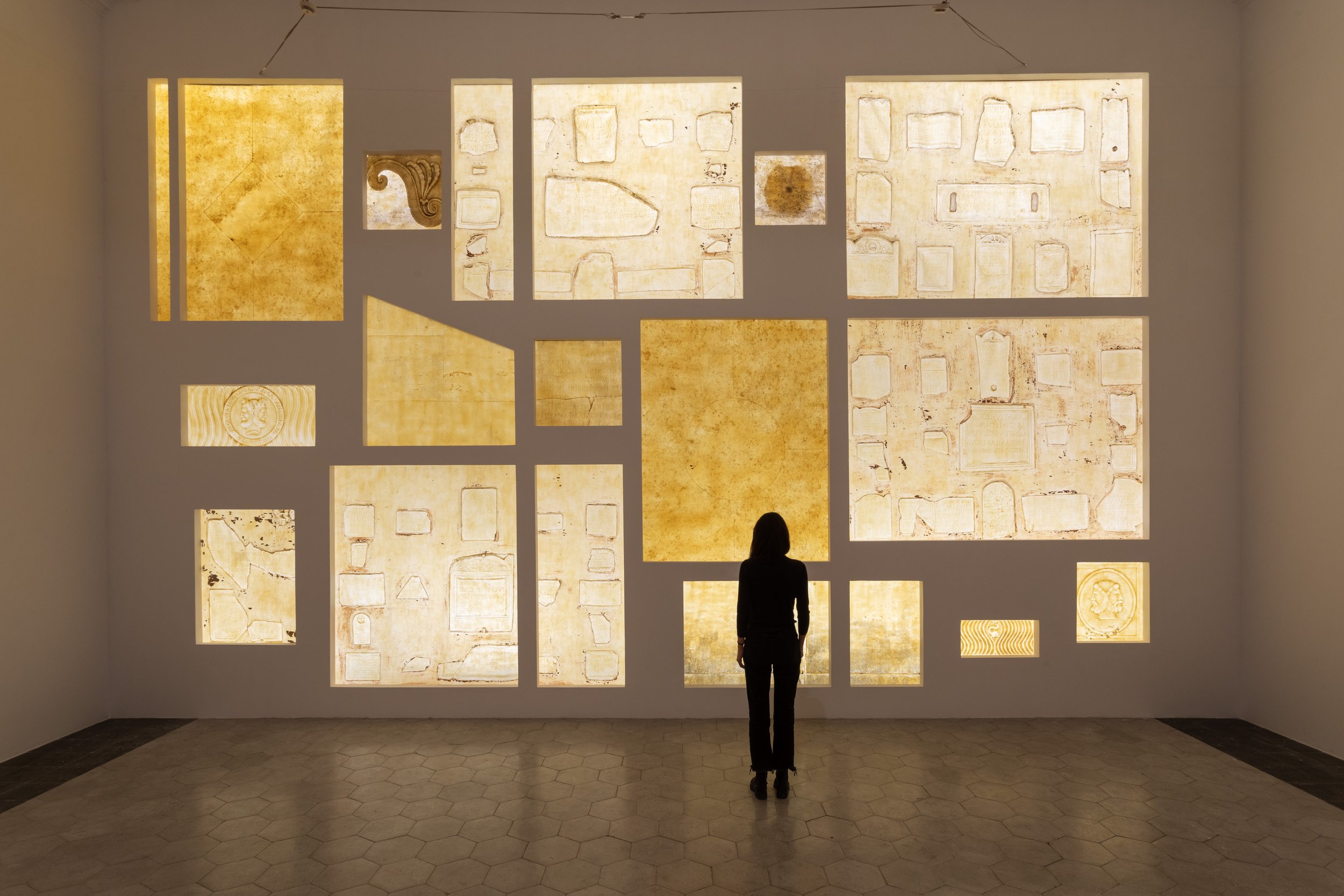Therefore by bodies unseen does nature perform its work (2022-ongoing)
On the right of this image, is a wall of the courtyard of the American Academy in Rome, studded with archaeological fragments, that also bears the traces of a recent cleaning process undertaken as part of an artistic intervention by 2022 Resident Jorge Otero-Pailos. The process is most apparent in the horizontal color delineation running near the springing of the arch, distinguishing cleaned (below) from uncleaned (above) architectural surfaces. Undertaken in five bays of the courtyard, it involved applying a latex coating to the walls which, when lifted, removed dust and other pollutants. The imprint of Otero-Pailos' work has been intentionally left there as a long-term installation, both to track changes in the courtyard and to provoke questions about conservation practices and the materiality of memory.
On the left of this image is the resulting dust cast as it was suspended and backlit in the Academy’s art gallery as part of the exhibition Regeneration (April 13 - June, 12, 2022), offering a materialization of the courtyard’s environmental history.
Working at the intersection of art, preservation and architecture, Otero-Pailos has a long-standing interest in both dust and fragments. Fragments are the language of Rome, characterizing so much of its post-antique building, where spolia often ornament later structures and in some cases even constitute their fabric. Dust is a micro-fragment, a bit of the physical world that has been cast off and then comes to land somewhere else, often embedding itself in a new materiality. The walls of this courtyard are part of a continual cycle of making and re-making.
This instability of surfaces is another interest of Otero-Pailos, and the traces of his work point to related questions in the field of art and architectural conservation. If change is continuous and the boundary between structure and environment is unclear, where does the work of conservators appropriately begin and where does it end? How do the marks of Otero-Pailos’s intervention compare to other signs of time and wear found on this building? What do we keep, what do we cover up, and what do we let go?
The title of this long term installation is the translation of “CORPORIBUS CAECIS IGITUR NATURA GERIT RES,” a verse from Lucretius’ scientific poem De rerum natura (c. 60 BCE), ‘On the Nature of Things’. It is the conclusion to a passage in which Lucretius, after observing dust particles, theorizes the existence of "unseen particles" as indivisible units of matter, a preliminary formulation of the theory of atoms after Epicurius.
Text by Elizabeth Rodini, AAR Director and Regeneration co-curator.
Photograph by Daniele Molajoli
Distributed Monuments, American Academy in Rome (2022)
Installation view of Distributed Monuments: American Academy in Rome. Latex and dust transferred from the American Academy in Rome, 2022, 912 cm x 591 cm. Courtesy of Otero-Pailos Studio, the American Academy in Rome and Sapar Contemporary. Photograph by Daniele Molajoli
Jorge Otero-Pailos works in latex casts, a conservation method used to remove dust and debris from historic monuments. During his Residency at the American Academy in Rome, he made casts of the building’s surfaces—including floors, architectural details, and the spolia-studded walls of the courtyard—which were then placed in a gigantic, back-lit frame. The casts preserve the topography of these surfaces along with the dust that had settled on them, re-presenting the longitudinal history of a building and its environment.
At the conceptual core of this work lies the matter of permanence. Monuments like those that define Rome were built to endure. But Otero-Pailos reveals the contingency of every surface, including those of monuments: they become dust just as they accrue it. “Buildings,” he says, “lend recognizable form to a dust that was formless and chaotic.” In the end, it is dust that remains—including the debris created by human activity and industry. Traces of ancient Roman silver mining still apparent in the ice packs of the Arctic, for example, suggest that pollution itself is the most lasting of human creations.
There are ethical implications to this vision, underscoring our responsibility to the environment in the short and long term. But the implications are also spiritual, beyond time and our ability to measure it. The dust that surrounds us also is us. It makes up buildings and falls away again into the atmosphere, reminding us of stardust and the materiality of creation itself.

